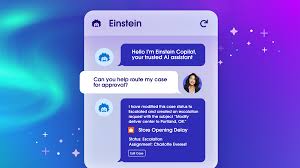Salesforce Einstein Copilot Security: How It Works and Key Risks to Mitigate for a Safe Rollout
With the official rollout of Salesforce Einstein Copilot, this conversational AI assistant is set to transform how sales, marketing, and customer service teams interact with both customers and internal documentation. Einstein Copilot understands natural language queries, streamlining daily tasks such as answering questions, generating insights, and performing actions across Salesforce to boost productivity.
Salesforce Einstein Copilot Security
However, alongside the productivity gains, it’s essential to address potential risks and ensure a secure implementation. This Tectonic insight covers:
- Einstein Copilot’s use cases
- How it works
- The Einstein Trust Layer for secure AI operations
- Best practices for a safe and responsible rollout
Einstein Copilot Use Cases
Einstein Copilot enables users to:
- Help sales reps find leads, create opportunities, update records, and summarize meetings.
- Assist service agents in resolving cases, accessing knowledge articles, and escalating issues.
- Empower marketers to create campaigns, write emails, segment audiences, and analyze results.
- Support merchants by managing online stores, handling inventory, processing orders, and more.
- Enable users to analyze data, create reports, discover trends, and generate dashboards.
All of these actions can be performed with simple, natural language prompts, improving efficiency and outcomes.
How Einstein Copilot Works
Here’s a simplified breakdown of how Einstein Copilot processes prompts:
- A user inputs a prompt in Salesforce Sales, Marketing, or Service Cloud.
- Einstein Copilot processes the prompt by conducting a similarity search across connected data sources.
- The prompt and response are then filtered through the Einstein Trust Layer for security.
- The AI-generated response is provided within Salesforce.
The Einstein Trust Layer
Salesforce has built the Einstein Trust Layer to ensure customer data is secure. Customer data processed by Einstein Copilot is encrypted, and no data is retained on the backend. Sensitive data, such as PII (Personally Identifiable Information), PCI (Payment Card Information), and PHI (Protected Health Information), is masked to ensure privacy.
Additionally, the Trust Layer reduces biased, toxic, and unethical outputs by leveraging toxic language detection. Importantly, Salesforce guarantees that customer data will not be used to train the AI models behind Einstein Copilot or be shared with third parties.
The Shared Responsibility Model
Salesforce’s security approach is based on a shared responsibility model:
- Salesforce is responsible for securing its platform, services, and AI architecture, ensuring safe processing of customer data via Einstein Copilot.
- Customers are responsible for securing application configurations, permissions, and data quality to ensure AI-powered tasks are executed responsibly.
This collaborative model ensures a higher level of security and trust between Salesforce and its customers.
Best Practices for Securing Einstein Copilot Rollout
- Lock Down Permissions to Sensitive Data Einstein Copilot inherits user permissions, meaning it can access all organizational data a user can. It’s crucial to restrict sensitive data access based on job roles to mitigate risks.
- Analyze permissions for each user, including Profiles, Permission Sets, and Role Hierarchy, to ensure proper data access.
- Keep your security teams involved in permission analysis, as large enterprises may have complex permissions systems.
- Update and Clean Internal Data Einstein Copilot relies on your Salesforce Data Cloud to access accurate, up-to-date data. Stale or inaccurate information can lead to erroneous AI outputs. Ensure:
- Data is secure, clean, and timely.
- Outdated or irrelevant records and documentation are purged or updated regularly.
- Identify Sensitive Data Ensure that sensitive data is segmented, so Einstein Copilot doesn’t access it. Salesforce allows you to create data zones to restrict what data the AI can access.
- Ensure Proper Use with Prompt Guardrails Use Salesforce’s Prompt Builder to create AI input templates and establish guardrails for different processes. This ensures that the AI provides accurate, on-topic responses and prevents prompt injection attacks, where malicious inputs could lead to unauthorized AI actions.
Prepare Your Salesforce Org for Einstein Copilot
To ensure a smooth rollout, it’s critical to assess your Salesforce security posture and ready your data. Tools like Salesforce Shield can help organizations by:
- Simplifying permissions analysis.
- Automatically discovering and classifying sensitive data.
- Surfacing stale data.
- Identifying critical misconfigurations.
- Monitoring sensitive data activity and detecting risky behaviors.
By following these steps, you can utilize the power of Einstein Copilot while ensuring the security and integrity of your data.













